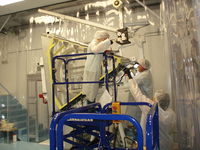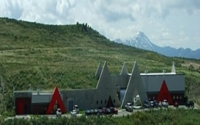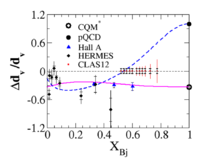Difference between revisions of "PhysWebPageBannerContent"
| Line 35: | Line 35: | ||
=Nucleon's Fractional Down Quark Polarization= | =Nucleon's Fractional Down Quark Polarization= | ||
| + | |||
| + | The contributions of a nucleon's constituents, quarks, to the spin of the nucleon has been a long standing questing since the 1980s when it was first observed that they contribute less than 40 %. | ||
| + | The spin physics program at ISU is working to measure the contribution of a nucleon's down quark flavors to its spin. This is referred to a the down aura fractional polarization. Measurements of this quantity have yet to show Quantum Chromodynamics, the main theoretical framework for the nuclear force, | ||
| + | |||
| + | While the constituent quark model (CQM) predicts that $\frac{\Delta d}{d}$ rema | ||
| + | ins negative as $x_B$ approaches unity, perturbative quantum chromodynamics (pQC | ||
| + | D) predicts that it will become positive, as shown in a Figure~\ref{fig:DeltaDov | ||
| + | erD}. This large difference between the two predictions now relies on experimen | ||
| + | t to resolve the disagreement. The current measurements shown in Figure~\ref{fi | ||
| + | g:DeltaDoverD} have not shown a clear indication of this predicted sign change a | ||
| + | s there is a sparsity of data beyond $x_B > 0.5$. | ||
| + | As recognized in the 2007 long range plan, there is a clear need to perform meas | ||
| + | urements above $x_B$ of 0.5 in order to evaluate the veracity of the pQCD and CQ | ||
| + | M predictions. The 2007 long range plan predicted that the data from an upgrade | ||
| + | d JLab will play a large role in this evaluation of the two predictions. | ||
| + | One of the goals of experiment E12-06-109 (co-PI Forest), in JLab's Hall B, is t | ||
| + | o measure $\frac{\Delta d}{d}$ above $x_B$ of 0.5. Figure~\ref{fig:DeltaDoverD} | ||
| + | illustrates the precision that may be achieved using the CLAS12 | ||
| + | apparatus. | ||
| + | |||
| + | In particular, the measurement at $x_B$ of 0.7 should distinguish between the tw | ||
| + | o prediction at the 2$\sigma$ level. | ||
| + | The comprehensive data set to be collected by experiment E12-06-109 will also co | ||
| + | ntribute substantially to our knowledge of polarized parton distribution functio | ||
| + | ns for all quark flavors and even the polarized gluon distribution $\Delta g$, w | ||
| + | hich is also being pursued at the Relativistic Heavy Ion Collider (RHIC). | ||
| + | Through Next-to-Leading Order (NLO) analysis of the world data on inclusive DIS | ||
| + | (using the DGLAP evolution equations), one can constrain these distribution func | ||
| + | tions and their integrals. | ||
| + | Existing CLAS data from 6 GeV have already made an impact on these fits. The exp | ||
| + | ected data from the proposed experiment at 11~GeV will further reduce the uncert | ||
| + | ainties of these distributions. | ||
| + | |||
| + | |||
[[File:DeltadOverd_11-21-16.png| 200 px]] | [[File:DeltadOverd_11-21-16.png| 200 px]] | ||
Revision as of 22:55, 21 November 2016
Physics Department Mission /overview
Our mission: The mission of the Idaho State University Department of Physics is to pursue cutting edge research in both fundamental and applied physics, and train of the next generation of physical scientists, technicians, and educators.
- Overview
The Idaho State University Department of Physics is actively engaged in a variety of cutting edge research pursuits, all of which focus on the use of experimental nuclear physics techniques to address problems in both fundamental and applied science. Major efforts include:
- nuclear non-proliferation and homeland security
- radiation effects in materials and devices
- nuclear reactor fuel cycle physics
- accelerator applications
- biology
- fundamental nuclear and particle physics.
Clean Room
The Idaho Accelerator Center and ISU's Department of Physics are building detectors for an upgrade of Jefferson Lab's Hall B. The detectors are wire chambers containing approximately 5,000, 30 micron diameter wires that are used to form gaseous cells which can detect the passage of ionizing particles. The 2 year long project will construct detectors that are about 6 feet high and will eventually be installed at Jefferson Lab in Newport News, Va. The detectors will be part of a larger detector that will be used by a group of more than 100 physicists to perform fundamental nuclear physics measurements.
The Idaho Accelerator Center (IAC)
The Idaho Accelerator Center (IAC) is a research facility operated by Idaho State University located in southeast Idaho. It provides opportunities for scientists and engineers from the University, the private sector and the national laboratories to utilize specialized nuclear facilities. It serves as a principal investigating conduit for R&D in nuclear physics applications in materials science, biology, homeland and national security. Student's from the Physics department are involved in all aspects of the center, from operating electron accelerators to performing experiments in nuclear physics applications. For more information go to iac.isu.edu.
Nucleon's Fractional Down Quark Polarization
The contributions of a nucleon's constituents, quarks, to the spin of the nucleon has been a long standing questing since the 1980s when it was first observed that they contribute less than 40 %. The spin physics program at ISU is working to measure the contribution of a nucleon's down quark flavors to its spin. This is referred to a the down aura fractional polarization. Measurements of this quantity have yet to show Quantum Chromodynamics, the main theoretical framework for the nuclear force,
While the constituent quark model (CQM) predicts that $\frac{\Delta d}{d}$ rema ins negative as $x_B$ approaches unity, perturbative quantum chromodynamics (pQC D) predicts that it will become positive, as shown in a Figure~\ref{fig:DeltaDov erD}. This large difference between the two predictions now relies on experimen t to resolve the disagreement. The current measurements shown in Figure~\ref{fi g:DeltaDoverD} have not shown a clear indication of this predicted sign change a s there is a sparsity of data beyond $x_B > 0.5$. As recognized in the 2007 long range plan, there is a clear need to perform meas urements above $x_B$ of 0.5 in order to evaluate the veracity of the pQCD and CQ M predictions. The 2007 long range plan predicted that the data from an upgrade d JLab will play a large role in this evaluation of the two predictions. One of the goals of experiment E12-06-109 (co-PI Forest), in JLab's Hall B, is t o measure $\frac{\Delta d}{d}$ above $x_B$ of 0.5. Figure~\ref{fig:DeltaDoverD}
illustrates the precision that may be achieved using the CLAS12
apparatus.
In particular, the measurement at $x_B$ of 0.7 should distinguish between the tw o prediction at the 2$\sigma$ level. The comprehensive data set to be collected by experiment E12-06-109 will also co ntribute substantially to our knowledge of polarized parton distribution functio ns for all quark flavors and even the polarized gluon distribution $\Delta g$, w hich is also being pursued at the Relativistic Heavy Ion Collider (RHIC). Through Next-to-Leading Order (NLO) analysis of the world data on inclusive DIS (using the DGLAP evolution equations), one can constrain these distribution func tions and their integrals. Existing CLAS data from 6 GeV have already made an impact on these fits. The exp ected data from the proposed experiment at 11~GeV will further reduce the uncert ainties of these distributions.


